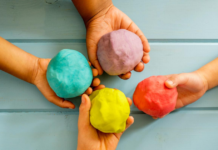Airy foam, bewitching aroma and thin streams of water - all this, like nothing else, can cheer you up in the morning and relax before a quiet sleep. But the double pleasure will bring understanding that the bar, gently gliding over the body, is made independently and exclusively for itself. Therefore, it is worth familiarizing yourself with the simplest technology of how to make soap at home in accordance with personal preferences and needs.
Material Content:
Soap pen sample
To do the same, only your own unique soap, you do not need so much. In fact, the recipe is very simple: the main thing is to strictly follow the instructions.
Step one
We get components. The base will serve as a children's soap. It is advisable to purchase its hypoallergenic version, without perfumes. In addition, an oil base should be selected. As a rule, for beginners it is recommended to take sunflower or olive oil. But, having worked out the technology, you can start experimenting with other oils, such as rosehip, grape seed, coconut or sea buckthorn. The third component necessary for cooking soap is glycerin. His presence is extremely desirable, because it is thanks to him that a special moisture-saving layer is created on the skin. And finally, boiling water.
Second step
We are preparing a “working” toolkit. Before you cook the soap, you should prepare a set for creation at home. So, you need a grater to form large flakes, medical goggles and gloves, three containers (to create a steam bath and the formation of soap chips), a whisk and molds.
Step three
The mystery of soap making. For this basic recipe, you need 180 grams of baby soap to grate on a coarse grater.Needless to say, in the process of preparing soap flakes, it is necessary to protect the eyes and respiratory system? If so, then before starting the soap making process, it is worth protecting your own vision and breathing with glasses and a mask.
Once the cereal has been cooked, you can proceed directly to cooking. To do this, five tablespoons of oil are mixed with two of the same tablespoons of cosmetic glycerin and heated in a steam bath to about 40 degrees. Then carefully add soap flakes and boiling water. By the way, the volume of the latter should be 100 ml. In the process of cooking, the mass must be constantly stirred, and it is best to do this with a whisk, which will help to avoid lumps.
As soon as the consistency began to resemble mashed potatoes, they remove it from the bath and proceed to molding. To do this, pre-prepared molds for the future soap are lubricated with the oil on the basis of which it was prepared. And only then the mass is carefully placed for solidification.
By the way, you can use almost any capacity: it’s children’s little ones, and silicone baking dishes, and special professional soap molds. As soon as the mixture hardens, it should be removed and transferred to paper, which should be dried in the open air for three days.
As you can see, both the recipe and the process are so simple that they are accessible even to those who have never tried themselves in this type of creativity. However, unfortunately, the result will be the same if you do not include additional ingredients in the recipe.
Different soap is needed, different soap is important
And in order to make soap the most beloved, but also distinguished by practicality and aesthetic appearance, additional ingredients are added to it, in the process of creation.
Scrub soap
Make it not as difficult as many people think. It is enough to slightly supplement the basic structure. So, the best properties of soft exfoliation of dead skin cells are rightly considered ground coffee, ground bones of cherries or apricots, oatmeal, chopped dried herbs and inflorescences, culinary poppy.
There is another feature of this type of home soap - its oil base. It is worth abandoning the types proposed above, replacing them with grape seed oil (soften and tone the skin), shea and sesame seeds (anti-aging and tonic effect), almonds and cocoa (regenerating and anti-inflammatory effect).
How to make homemade scrub soap?
In general, the process is similar to that presented above. Only instead of the traditional oil base do they choose the oil that best matches the functions of the future soap. But it is worth adding scrubbing substances only when the mixture has been removed from the bath, but before pouring into the molds.
Cosmetic soap
Favorite soap can become a kind of mini-salon. To do this, just add certain additives to the already prepared mixture. So, to remove excessive redness of the skin, honey is injected into the soap mass. At the same time, add three spoons of the sweet product to the basic recipe presented above.
In order to gradually even out skin tone and partially whiten it, it is enough to add white clay powder. Also, do not forget that the essential oils of many plants are excellent ingredients. For example, orange perfect is suitable for those who have uneven skin surface. Bergamot and eucalyptus are suitable for those who suffer from reduced immunity.
But you can simply add your favorite fragrance and enjoy its notes on the skin. To do this, it will be enough to just add a few drops of perfume to the finished, but not frozen mixture. Only perfume should be used, not perfumed and, of course, not eau de toilette.
This is worth knowing: trial and error
Creativity is not for nothing called the trial and error process. So soap making can overshadow enough common mistakes that most beginner soap makers make.
The most common of these is adding a larger volume of oil base than necessary. Such a volume will not only make the soap too oily, but also stop soaping. Therefore, it is best to strictly follow the recipe: one tablespoon of oil per 90 grams.
The second mistake is a misunderstanding of the staining processes. To create shades at the very beginning, it is best to use food coloring. But with natural ones, it is best to “work out” the cooking process by the sample method. So, if you add turmeric, you can really get different shades of yellow. But the petals of Hibiscus instead of intense red will give the soap-maker a dirty green hue. Indeed, some plant components in the reaction with glycerin "behave" not in the most predictable way.
But do not despair, because cooking soap is so exciting that even mistakes can turn out to be good luck in creating a new recipe.













